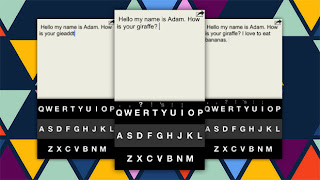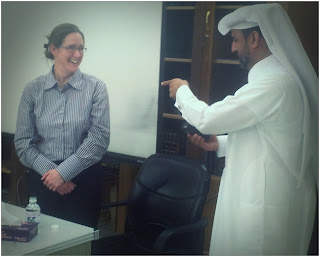Assistive Technology for Dyslexia in Arabic:
Encouraging this Old Dog to start thinking about New Tricks!
 |
| Dyslexia in Arabic - is it that Different? |
For those of us who have spent the greater part of our
careers working in one language, such as English, one of the most interesting
things about working in a new culture is how we are forced to disassemble all
we assume and all we think we know about Dyslexia.
I’ve just spent an unbelievably interesting day, trying to
gain a greater insight as to how Dyslexia represents itself when a child or
adult is reading or writing in Arabic.
When I arrived in Doha two years ago I grappled with
learning Arabic. My enthusiasm was
without question; my ability however fell a lot shorter. This was my starting point in appreciating the profound differences between not just both languages but how people learn or teach each of these languages.
For the first time, I became truly aware that how a language is learnt is guided not just by the trends and fashions of teaching but also by the language itself.
Thinking about this in the context of finding technology to support those with Dyslexia in Arabic - for an English speaker was truly an onion worth peeling, in spite of the anticipated tears!
Dyslexia is often described as a specific learning difficulty
and as such it reveals itself in many different ways. Dyslexia is not just a
difficulty with words, or the ability to read and write. As such, the use of technology that only helps
with spelling and reading often disregards some underlying difficulties that
may be impacting the natural development of these skills.
(Click on the link below to learn more)
Often Dyslexia is inaccurately characterized as being a
diagnosis of convenience for children who are just poor at spelling, reading or
handwriting which can be fixed by practice, effort, hard work and when all else
fails a good old spellchecker.
For anyone with Dyslexia however, and for those of us who
have worked first hand with children and adults with this learning difficulty
the reality is much more nuanced, much more complicated and requires more
sophisticated solutions. We have, over
time watched the software and technology mature, and we’ve seen developments come and go, but for English Speakers with Dyslexia, there are real valuable tools out there. Word Prediction, Text to Speech, Object Character Recognition software, Software supporting multi-sensory learning are now common tools. Software titles such as Kurzweil 3000, Text Help, Co-Writer, Penfriend, Ginger, Claroread and a multitude of other titles have become household names, insofar as is possible in the AT community.
Moving to work in a space where Arabic is the primary
language used in community life, and for the most part in Education, it forces
us to challenge all that we think we know about Dyslexia. This has been one of the times, where I have
had to reflect on how I have developed my belief system about assessment for
Dyslexia and how technology can best meet the needs of children and adults
struggling with print literacy.
(Click on the link below for more information on Dyslexia
and Arabic)
Today I spent some time in the company of a new friend and
colleague, Dr Gad Elbeheri, a lecturer in the Australian University in Kuwait
who has an appreciation for and understanding of Dyslexia in Arabic based on
his research and investigation over the past number of years. What was most interesting to me was how he
explained how the sound of a language often dictates how it is traditionally
taught. He confirmed for me something I
was beginning to suspect, i.e., the primacy of traditional literacy teaching based
on auditory skills that we see in English language education is not as applicable
when learning Arabic. Of more interest
to me was the fact that, although I knew that written Arabic is a morphological
language, which has a transformative quality based on context etc., creates
another layer of abstraction for students struggling with learning.
We spoke at length about predictors for development of good
functional literacy in English and in Arabic and compared stories of
experiences we had.
So what does this have to do with Assistive Technology?
In English we have a history of using technology to address
Dyslexia which stretched back till at least the early 90’s if not before.
For more information click on this link: http://dyslexiahelp.umich.edu/tools/software-assistive-technology
.
However, as the Assistive Technology industry in the Arabic
speaking world has not had as much time to mature, there is not the same range
of solutions available for people. Over
the past two years, Mada has tried to address this issues by supporting the
development and localization of specific software products aimed at directly supporting
those with Dyslexia, including and Arabic version of Clicker 5, an Arabic Claroread
and an Arabic
version of the FXC Open source Utilities.
There are many challenges ahead, in particular tacking
Object Character Recognition and Voice Recognition software, particularly for
those requiring compensatory strategies.
With challenges, however there are opportunities.
One thing that struck me today was the value of conversation
and debate, a few hours in the company of a knowledgeable and generous
colleague is worth weeks of research.
Debate and discussion is healthy and productive.
Most importantly we both agreed on several points:
- 1. There is a real and immediate demand for technology that will support those with Dyslexia
- 2. The technology cannot just focus on compensation, as doing so would deny many children the significant benefits that can be gained through learning with a technology partner.
- 3. New technology developed must be based on research and data as to how Dyslexia manifests in those learning to read and write in Arabic.
- 4. Bringing academics, technologists, educators and children together will be the key to developing good solutions.
There is nothing new in this, nothing we haven’t considered
before, I have however grateful for the opportunity to talk with a colleague
and in partnership re-affirm a road forward in being part of the process of
ensuring that technology can be used to minimize the difficulties and maximize
the opportunities for people with Dyslexia.
For more information feel free to click on the links below:


